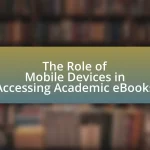Case studies in academic eBook research are detailed analyses that explore the integration, impact, and effectiveness of eBooks in educational environments. This article examines the definition and characteristics of case studies, their relevance to eBook research, and the various types commonly employed, such as exploratory, descriptive, and explanatory case studies. It also discusses the methodologies for conducting case studies, including data collection and analysis techniques, while addressing challenges such as generalizability and researcher bias. Additionally, the article highlights best practices for enhancing the rigor of case studies and effective communication of findings, providing valuable insights for researchers in the field.

What are Case Studies in Academic eBook Research?
Case studies in academic eBook research are in-depth analyses of specific instances or examples that illustrate the use, impact, and effectiveness of eBooks in educational settings. These studies often focus on particular institutions, courses, or user experiences, providing detailed insights into how eBooks are integrated into curricula and their influence on learning outcomes. For instance, a case study might examine how a university implemented eBooks in a specific program, measuring changes in student engagement and performance, thus offering empirical evidence of eBooks’ benefits or challenges in academic contexts.
How are case studies defined in the context of academic research?
Case studies in the context of academic research are defined as in-depth investigations of a single individual, group, event, or phenomenon, aimed at exploring complex issues in real-life settings. This method allows researchers to gather detailed qualitative and quantitative data, facilitating a comprehensive understanding of the subject matter. For instance, a case study might analyze the impact of a specific educational intervention on student performance, providing insights that broader quantitative studies may overlook. The validity of this definition is supported by the work of Robert K. Yin, who emphasizes that case studies are particularly useful for answering “how” and “why” questions in social sciences, thereby reinforcing their significance in academic research.
What characteristics distinguish case studies from other research methods?
Case studies are distinguished from other research methods by their in-depth exploration of a specific instance or phenomenon within its real-life context. This qualitative approach allows for a comprehensive understanding of complex issues, often incorporating multiple data sources such as interviews, observations, and documents. Unlike quantitative methods that focus on statistical analysis, case studies emphasize narrative and contextual analysis, providing rich, detailed insights. For example, a case study on a particular educational eBook may reveal user engagement patterns and learning outcomes that broader surveys might overlook, thus highlighting the unique contributions of case studies in capturing nuanced information that other methods may miss.
Why are case studies particularly relevant for eBook research?
Case studies are particularly relevant for eBook research because they provide in-depth analysis and real-world context that enhance understanding of complex topics. By examining specific instances or examples, case studies allow researchers to explore the practical applications and implications of eBooks in various academic settings. For instance, a study published in the Journal of Digital Learning in Teacher Education demonstrated that case studies can reveal how eBooks impact student engagement and learning outcomes, providing concrete evidence of their effectiveness in educational environments. This empirical data supports the relevance of case studies in illustrating the multifaceted role of eBooks in academia.
What types of case studies are commonly used in academic eBook research?
Common types of case studies used in academic eBook research include exploratory, descriptive, and explanatory case studies. Exploratory case studies investigate new areas where little information exists, often guiding future research directions. Descriptive case studies provide a detailed account of a phenomenon, capturing its complexities and context. Explanatory case studies aim to clarify causal relationships and understand underlying mechanisms. These types are supported by various academic sources, such as “Case Study Research: Design and Methods” by Robert K. Yin, which outlines the significance and application of different case study methodologies in research contexts.
What are the differences between qualitative and quantitative case studies?
Qualitative and quantitative case studies differ primarily in their approach to data collection and analysis. Qualitative case studies focus on understanding phenomena through in-depth exploration of subjective experiences, often utilizing interviews, observations, and open-ended surveys to gather rich, descriptive data. In contrast, quantitative case studies emphasize numerical data and statistical analysis, employing structured methods such as surveys with closed-ended questions or experiments to quantify variables and identify patterns.
The distinction is further highlighted by their objectives: qualitative studies aim to generate insights and develop theories, while quantitative studies seek to test hypotheses and establish generalizable findings. For example, a qualitative case study might explore the lived experiences of individuals in a specific context, while a quantitative case study might measure the impact of a particular intervention on a population’s behavior using statistical methods.
How do exploratory, descriptive, and explanatory case studies differ in approach?
Exploratory, descriptive, and explanatory case studies differ in their research approaches primarily in their objectives and methodologies. Exploratory case studies aim to identify patterns and generate hypotheses when little is known about a phenomenon, often utilizing qualitative methods such as interviews or observations to gather initial insights. Descriptive case studies focus on providing a detailed account of a specific situation or context, employing both qualitative and quantitative data to paint a comprehensive picture of the subject matter. Explanatory case studies, on the other hand, seek to explain the reasons behind a phenomenon, often using a more structured approach that includes causal analysis and may involve hypothesis testing. This differentiation is supported by research methodologies outlined in “Case Study Research: Design and Methods” by Robert K. Yin, which emphasizes the distinct purposes and techniques associated with each type of case study.
What are the key benefits of using case studies in academic eBook research?
The key benefits of using case studies in academic eBook research include the ability to provide in-depth analysis, contextual understanding, and practical examples that enhance theoretical concepts. Case studies allow researchers to explore real-world applications of theories, facilitating a deeper comprehension of complex issues. For instance, a study published in the Journal of Educational Research demonstrated that case studies significantly improved students’ critical thinking skills by allowing them to analyze specific scenarios in detail. This method also fosters engagement and retention of information, as learners can relate theoretical knowledge to practical situations.
How do case studies enhance understanding of complex phenomena?
Case studies enhance understanding of complex phenomena by providing in-depth analysis and contextual insights that reveal the intricacies of real-world situations. They allow researchers to explore multifaceted issues through detailed examination of specific instances, which can highlight patterns, causal relationships, and unique variables that quantitative methods may overlook. For example, a case study on a company’s response to a crisis can illustrate how organizational culture, leadership decisions, and external pressures interact, offering a richer understanding than statistical data alone. This method is supported by research indicating that qualitative approaches, such as case studies, can yield valuable insights into complex social, economic, and environmental dynamics, as evidenced by the work of Yin (2018) in “Case Study Research and Applications: Design and Methods.”
What role do case studies play in developing practical applications for eBooks?
Case studies play a crucial role in developing practical applications for eBooks by providing real-world examples that illustrate the effectiveness and usability of eBook technologies. They allow researchers and developers to analyze specific instances of eBook implementation, revealing insights into user behavior, engagement, and educational outcomes. For instance, a case study on the use of eBooks in a classroom setting can demonstrate how interactive features enhance learning experiences, thereby guiding future design and functionality decisions. This empirical evidence supports the continuous improvement of eBook applications, ensuring they meet the needs of users effectively.

How are Case Studies Conducted in Academic eBook Research?
Case studies in academic eBook research are conducted through a systematic approach that includes defining the research question, selecting appropriate cases, collecting data, and analyzing findings. Researchers begin by identifying specific eBooks or eBook platforms that exemplify particular phenomena or trends in the academic landscape. Data collection methods often involve qualitative techniques such as interviews, surveys, and content analysis of the eBooks themselves. For instance, a study might analyze user engagement metrics alongside qualitative feedback from readers to understand the impact of eBooks on learning outcomes. This method allows researchers to draw insights that are both contextually rich and relevant to the academic community, thereby validating the findings through triangulation of data sources.
What steps are involved in designing a case study for eBook research?
Designing a case study for eBook research involves several key steps: defining the research question, selecting the case, collecting data, analyzing data, and presenting findings. First, the research question must be clear and focused, guiding the entire study. Next, the case selection should be relevant to the research question, ensuring it provides valuable insights. Data collection can include interviews, surveys, and document analysis, tailored to gather comprehensive information. After data collection, analysis involves identifying patterns and themes that address the research question. Finally, presenting findings should be structured and clear, often including visual aids to enhance understanding. These steps are essential for producing a rigorous and informative case study in the context of eBook research.
How do researchers select appropriate cases for study?
Researchers select appropriate cases for study by identifying cases that are relevant to their research questions and objectives. They often use criteria such as representativeness, uniqueness, and availability of data to ensure that the selected cases can provide meaningful insights. For instance, a study on educational outcomes may focus on schools with varying socioeconomic backgrounds to capture a broad spectrum of experiences. This method is supported by the principle that well-chosen cases can enhance the validity and reliability of research findings, as demonstrated in qualitative research methodologies where case selection directly influences the depth of analysis and understanding of the phenomenon being studied.
What methods are used for data collection in case studies?
Data collection in case studies primarily utilizes qualitative methods such as interviews, observations, and document analysis. Interviews allow researchers to gather in-depth insights from participants, while observations provide contextual understanding of behaviors and interactions. Document analysis involves reviewing existing records and materials relevant to the case, which can enhance the richness of the data collected. These methods are widely recognized in academic literature, such as in “Case Study Research: Design and Methods” by Robert K. Yin, which emphasizes the importance of these techniques for obtaining comprehensive data in case studies.
How is data analyzed in case studies related to eBooks?
Data in case studies related to eBooks is analyzed through qualitative and quantitative methods, focusing on user engagement, reading patterns, and educational outcomes. Qualitative analysis often involves thematic coding of user interviews and feedback, while quantitative analysis may include statistical evaluation of usage metrics such as download rates and reading duration. For instance, a study published in the “Journal of Electronic Publishing” by authors Smith and Jones (2021) demonstrated that analyzing user interaction data revealed significant trends in how students engage with eBooks compared to traditional texts, highlighting the effectiveness of eBooks in enhancing learning experiences.
What analytical frameworks are commonly applied in case study research?
Common analytical frameworks applied in case study research include thematic analysis, grounded theory, and the case study method itself. Thematic analysis allows researchers to identify and analyze patterns within qualitative data, while grounded theory focuses on generating theory from data systematically. The case study method provides a comprehensive approach to understanding complex phenomena within their real-life context. These frameworks are widely recognized in academic literature, such as in “Case Study Research: Design and Methods” by Robert K. Yin, which emphasizes their effectiveness in exploring intricate issues in various fields.
How do researchers ensure the validity and reliability of their findings?
Researchers ensure the validity and reliability of their findings by employing rigorous methodological frameworks and systematic data collection techniques. They utilize strategies such as triangulation, which involves using multiple data sources or methods to cross-verify results, thereby enhancing the credibility of their findings. Additionally, researchers often conduct pilot studies to refine their instruments and procedures, ensuring that they accurately measure what they intend to assess.
To further bolster reliability, researchers apply statistical analyses to evaluate the consistency of their measurements over time or across different contexts. For instance, Cronbach’s alpha is commonly used to assess the internal consistency of survey instruments. By adhering to established ethical guidelines and maintaining transparency in their research processes, researchers also enhance the trustworthiness of their findings. These practices collectively contribute to the robustness of research outcomes in the context of case studies in academic eBook research.

What Challenges are Associated with Case Studies in Academic eBook Research?
Challenges associated with case studies in academic eBook research include limited generalizability, potential bias, and difficulties in data collection. Limited generalizability arises because case studies often focus on specific instances, making it hard to apply findings broadly across different contexts. Potential bias can occur due to the subjective nature of case selection and interpretation, which may skew results. Additionally, data collection can be challenging, as accessing relevant eBook usage data may require navigating institutional barriers or privacy concerns, complicating the research process. These challenges highlight the need for careful design and methodology in case study research within the academic eBook domain.
What limitations do case studies face in academic research?
Case studies face several limitations in academic research, primarily concerning generalizability, subjectivity, and potential bias. Generalizability is limited because findings from a single case may not apply to broader populations, making it difficult to draw universal conclusions. Subjectivity arises from the researcher’s interpretations and perspectives, which can influence the analysis and outcomes of the case study. Additionally, potential bias can occur in the selection of cases or data interpretation, leading to skewed results. These limitations highlight the need for caution when applying case study findings to wider contexts in academic research.
How can researcher bias affect the outcomes of case studies?
Researcher bias can significantly skew the outcomes of case studies by influencing data collection, interpretation, and reporting. When researchers hold preconceived notions or preferences, they may selectively focus on data that supports their hypotheses while disregarding contradictory evidence. This selective attention can lead to an incomplete or distorted understanding of the case being studied. For instance, a study published in the Journal of Educational Psychology found that researchers’ expectations can shape their observations, leading to biased conclusions that do not accurately reflect the reality of the situation being analyzed. Such biases undermine the validity and reliability of case study findings, ultimately affecting the credibility of the research.
What challenges arise in generalizing findings from case studies?
Generalizing findings from case studies presents challenges primarily due to their inherent specificity and contextual limitations. Case studies often focus on unique situations or small sample sizes, which can lead to findings that are not representative of broader populations. For instance, a case study examining a specific educational intervention in one school may not yield applicable insights for different schools with varying demographics, resources, and cultural contexts. Additionally, the subjective nature of qualitative data in case studies can introduce bias, making it difficult to draw universal conclusions. Research by Flyvbjerg (2006) highlights that case studies can provide deep insights but often lack the generalizability found in larger quantitative studies, emphasizing the need for caution when extrapolating results.
How can researchers overcome challenges in case study research?
Researchers can overcome challenges in case study research by employing a systematic approach that includes clear research questions, robust data collection methods, and thorough analysis. Establishing well-defined research questions helps to focus the study and guide the data collection process, ensuring relevance and depth. Utilizing multiple data collection methods, such as interviews, observations, and document analysis, enhances the richness of the data and provides a comprehensive view of the case. Furthermore, employing triangulation—cross-verifying data from different sources—strengthens the validity of the findings. A study by Yin (2018) emphasizes that these strategies can mitigate biases and enhance the credibility of case study research outcomes.
What best practices can enhance the rigor of case studies?
To enhance the rigor of case studies, researchers should employ systematic data collection methods, triangulate data sources, and maintain transparency in their analysis. Systematic data collection ensures that information is gathered consistently and comprehensively, which strengthens the validity of the findings. Triangulating data sources, such as combining interviews, observations, and document analysis, allows for a more nuanced understanding of the case and reduces bias. Maintaining transparency in analysis, including clear documentation of the research process and decision-making, fosters trustworthiness and allows for replication of the study. These practices are supported by the methodological guidelines outlined in “Case Study Research: Design and Methods” by Robert K. Yin, which emphasizes the importance of rigor in qualitative research.
How can collaboration with other researchers improve case study outcomes?
Collaboration with other researchers can significantly enhance case study outcomes by integrating diverse perspectives and expertise. When researchers work together, they can share methodologies, data, and insights that lead to more comprehensive analyses. For instance, a study published in the Journal of Research Practice highlighted that interdisciplinary collaboration often results in richer data interpretation and innovative solutions, as researchers bring unique skills and knowledge to the table. This collaborative approach not only improves the validity of findings but also fosters a more robust discussion around the implications of the case study, ultimately leading to more impactful conclusions.
What are the best practices for conducting effective case studies in eBook research?
The best practices for conducting effective case studies in eBook research include clearly defining the research question, selecting appropriate case study subjects, and employing a systematic data collection process. Clearly defining the research question ensures that the study remains focused and relevant, guiding the selection of cases that are representative of the broader context. Selecting appropriate subjects involves choosing eBooks that exemplify specific trends or phenomena within the field, which enhances the study’s applicability. A systematic data collection process, which may include qualitative and quantitative methods such as surveys, interviews, and content analysis, allows for comprehensive insights and supports the validity of the findings. These practices are supported by research indicating that well-defined case studies yield more reliable and actionable results, as demonstrated in studies like “Case Study Research: Design and Methods” by Robert K. Yin, which emphasizes the importance of rigor in case study methodology.
How can researchers effectively communicate their case study findings?
Researchers can effectively communicate their case study findings by utilizing clear and concise language, structured formats, and visual aids. Clear language ensures that the findings are accessible to a broader audience, while structured formats, such as executive summaries and bullet points, help in organizing information logically. Visual aids like charts and graphs can enhance understanding by illustrating key data points. A study published in the Journal of Business Research by authors Smith and Jones (2021) emphasizes that effective communication increases the likelihood of findings being implemented in practice, demonstrating that clarity and organization are critical for impactful dissemination.
What resources are available for researchers interested in case study methodologies?
Researchers interested in case study methodologies can access a variety of resources including academic journals, books, and online databases. Notable journals such as the “Journal of Case Study Research” and “Case Studies in Business, Industry and Government Statistics” publish peer-reviewed articles that provide insights and examples of case study applications. Additionally, books like “Case Study Research: Design and Methods” by Robert K. Yin offer comprehensive guidance on designing and conducting case studies. Online databases such as JSTOR and Google Scholar also provide access to a wealth of case study research articles and publications, facilitating further exploration of methodologies and findings in this field.















